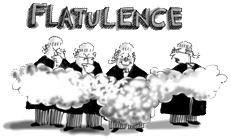Locking-up people who look dangerous
 Tulkinghorn •
Tulkinghorn •  Monday, January 14, 2013
Monday, January 14, 2013 Pre-trial preventive detention? ... Let's call it "refusal of bail" ... How can someone commit "further offences" when none have been proved to start with? ... Tulkinghorn examines NSW's proposed new Bail Act ... Conflict of values
Preventive detention is a concept that is employed to protect mentally ill people from harming themselves, to  isolate those with dangerous infectious diseases, or to treat seriously ill drug addicts and alcoholics.
isolate those with dangerous infectious diseases, or to treat seriously ill drug addicts and alcoholics.
It can also be used in the criminal law.
In the form of indefinite detention it can be used as a sentence for a crime or, when sentences expire or are about to, "preventive detention" schemes can involve citizens being ordered locked-up or kept locked-up, to prevent them engaging in future criminality.
That creates a second layer of punishment.
In Australia, preventive detention, commencing after the end of a jail sentence, imposed pursuant to specific legislation, was given a constitutional OK by the High Court in 2004 in the Fardon case.
In Double Punishment? Preventive Detention Schemes under Australian Legislation and their Consistency with International Law: The Fardon Communication by Patrick Keyzer and Sam Blay, the authors observe:
"Irrespective of the merits or flaws of preventive detention, it remains a politically attractive tool for any government in search of avenues in the criminal justice system within which to deal with perceptions of continuing criminal behaviour. Preventive detention law is an ostensible demonstration to the electorate that the government is taking serious measures to protect the community against crime."
"Pre-trial preventive detention" is something else again. It can be applied to people who have no criminal record at all.
It involves locking people up and need not be linked to crimes they have done, but for crimes they might do.
For many decades judges in Australia have been running pre-trial preventive detention regimes, tucked away in the bail process.
"There is no doubt that by permitting courts to refuse bail on the ground that the accused may commit further offences, Australia has established a system of preventive detention ... [which] rests upon an unproven factual assumption: that it is possible for courts to identify with some degree of accuracy people likely to commit crimes if released."
 For 13 centuries the problem of what to do with alleged criminals has remained the same
For 13 centuries the problem of what to do with alleged criminals has remained the same
Note the phrase "further offences". A magistrate or judge is allowed to say that in view of original offence(s), which haven't been proved, and in view of the fact that one is likely to commit "more", a person is ordered to be detained in custody.
The phrase is a dead giveaway and it is used quite a lot. If you search "commit further offences" and "bail" on Austlii you will get a lot of relevant results.
Incidentally, comparatively few bail decisions are officially reported.
The O'Farrell government intends to give NSW a revamped Bail Act this year.
Last year it got the NSW Law Reform Commission to produce a report, with reform recommendations, and on 28 November 28 the government produced a response to that report.
The NSWLRC 2012 report at para. 3.24 refers to the 1976 report, saying:
"The [1976] committee recommended that the likelihood of further offences being committed should not be regarded as a criterion relevant to bail. The committee noted that '[t]he place of this criterion in the common law is obscure: it does not appear in the classical statements, but in practice this newer ground for refusing bail has become one of the most important considerations'."
The NSW government's written response of November 28 last year was accompanied by a media release from the Premier titled "New Bail Laws to Put Community Safety First".
In 1983 Donald J. Harris (who went on to become Director of Policy Research and Statistics at the Pennsylvania Courts), produced an article entitled The Vested Interests of the Judge: Commentary on Flemming's 'Theory of Bail'.
He pointed out that many centuries ago the primitive and immediate ways of doing justice ...
"gradually gave way to a more deliberative justice, eventually resulting in an interval between accusation and trial.
But this created a conflict of values. The idea that the culpable might abscond, leaving the community deprived of its due, ran counter to the notion, at that point rude and tentative, that an accused person should not be deprived of ... liberty until a formal adjudication of guilt.
Bail was an attempt to reconcile this conflict. Roughly 13 centuries later the problem of what to do with the alleged criminal remains fundamentally the same."
According to Harris, two theories of bail emerged. The first emphasises the presumption of innocence and says:
"Bail has as its sole purpose ... the ... objective of insuring the appearance of the defendant at future court proceedings."
Under this theory, a dangerous defendant, who is addicted to committing violent crime, who has a criminal record, which requires metres of paper to print, but who has always answered to bail, should get it.
The second theory holds, among other things, that:
"The presumption of innocence was never meant to apply to proceedings before trial ...
Bail under this theory may properly serve two purposes: compelling appearance in court and the preventive custody of dangerous defendants."
One could argue that if the Premier wants a wide ranging pre-trial preventive detention regime, then he should try to legislate one openly, and not hide it in bail law.
And, by the way, it is not a valid excuse for pre-trial preventive detention to say judges give credit for time served under it, at the time of sentencing. What about those who are found to be innocent?
However, the NSW Law Reform Commission is not insisting on a separate regime.
Instead, it has recommended that the new Bail Act should make bail entitlement depend on five mandatory considerations (recommendation 10.2 pages 162-3).
The first two are pretty waffly, as is the fifth, and could be used to justify almost anything.
The fourth mandatory consideration is, "the protection and welfare of the community having regard to the likelihood that the person will commit a serious offence if released".
At the same time the commission's report manages to say (end of page 163):
"d) There should be no punishment by the state without conviction according to law."
And (para. 10.61 page 154):
"The use of bail law to prevent a potential future crime - preventive detention - has always been problematic.
In 1975 the Australian Law Reform Commission rejected such a provision, as did the Bail Review Committee in 1976."
In his 1970 book Crime in America, 1970 at page 313-15 former US Attorney General Ramsey Clark wrote:
"If we believe we can predict whether a person accused of a crime will be dangerous upon release before trial, why not go one step further?
Why should authorities wait until persons have been charged with a crime before jailing them?
If we can predict the next crime, we could have predicted the last one. Why not just round-up those persons who look dangerous and put them in jail?"
The legislative framework could be named The Locking Up People Who Look Dangerous Act.
No doubt the Premier's spin doctors could think of a name that is more innocuous, yet still politically rewarding.
 Bail,
Bail,  Preventative detention
Preventative detention 









Reader Comments